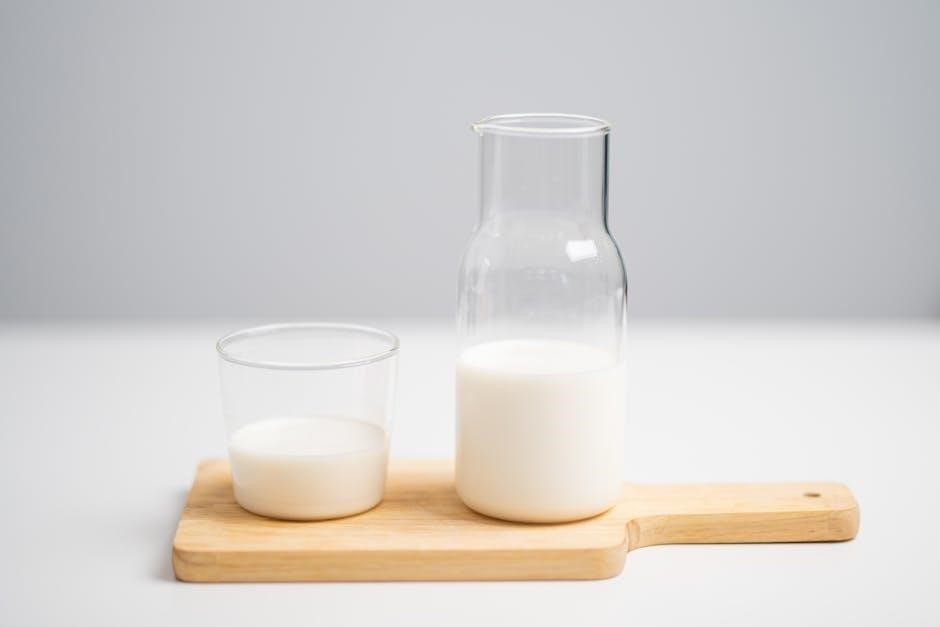
lactose intolerance diet plan pdf
Lactose Intolerance Diet Plan PDF: A Comprehensive Guide
Embark on a journey to understand and manage lactose intolerance effectively. This comprehensive guide offers valuable insights and practical tips for creating a personalized lactose intolerance diet plan. Discover how to navigate food choices and maintain a balanced diet.
Understanding Lactose Intolerance
Lactose intolerance is a common digestive issue where the body struggles to digest lactose‚ a sugar primarily found in milk and dairy products. This occurs when the small intestine doesn’t produce enough lactase‚ the enzyme responsible for breaking down lactose into simpler sugars that the body can absorb. Undigested lactose ferments in the colon‚ leading to uncomfortable symptoms.
Several factors can contribute to lactase deficiency‚ including genetics‚ age‚ and certain medical conditions. While lactose intolerance isn’t an allergy‚ it can significantly impact quality of life. Many individuals can manage their symptoms through dietary adjustments. These adjustments often include reducing lactose intake or consuming lactose-free alternatives.
Understanding the underlying causes and symptoms is crucial for developing an effective lactose intolerance diet plan. This plan will help individuals identify lactose sources in their diet and implement strategies to minimize discomfort. With careful planning and awareness‚ those with lactose intolerance can still enjoy a varied and nutritious diet while managing their symptoms effectively. Consulting with a dietitian can provide personalized guidance.
What is Lactose Intolerance?
Lactose intolerance is a digestive disorder characterized by the body’s inability to fully digest lactose‚ a type of sugar prevalent in milk and dairy items. This inability stems from a deficiency of lactase‚ an enzyme produced in the small intestine that is crucial for breaking down lactose into simpler sugars‚ glucose and galactose‚ which can then be easily absorbed into the bloodstream.
When lactose remains undigested‚ it travels to the colon where it undergoes fermentation by bacteria. This fermentation process leads to the production of gases and other byproducts‚ which are responsible for the uncomfortable symptoms associated with lactose intolerance. These symptoms may include bloating‚ gas‚ diarrhea‚ and abdominal cramps‚ varying in intensity depending on the amount of lactose consumed and the degree of lactase deficiency.

It’s important to distinguish lactose intolerance from a milk allergy. Lactose intolerance is a digestive issue‚ while a milk allergy involves an immune response to milk proteins. While both conditions require dietary modifications‚ the underlying mechanisms and potential severity differ significantly. Understanding the nature of lactose intolerance is the first step towards effective dietary management.
Causes of Lactose Intolerance
Lactose intolerance arises primarily from a deficiency in lactase production‚ the enzyme responsible for breaking down lactose in the small intestine. Several factors can contribute to this deficiency‚ leading to varying degrees of lactose intolerance. Primary lactose intolerance‚ the most common type‚ is genetically determined. Lactase production naturally declines with age‚ often becoming noticeable in adulthood. This gradual reduction is influenced by ethnicity‚ with higher prevalence rates observed in certain populations.
Secondary lactose intolerance develops as a result of damage to the small intestine caused by illness‚ injury‚ or surgery. Conditions such as gastroenteritis‚ Crohn’s disease‚ or celiac disease can impair lactase production temporarily or permanently. Treating the underlying condition may restore lactase production in some cases.
Congenital lactose intolerance is a rare genetic disorder where infants are born with little or no lactase. This condition requires specialized lactose-free infant formulas from birth. Developmental lactose intolerance can occur in premature infants whose small intestines are not fully developed‚ resulting in temporary lactase deficiency. Understanding the specific cause of lactose intolerance is crucial for tailoring appropriate dietary strategies and managing symptoms effectively.
Symptoms of Lactose Intolerance
The symptoms of lactose intolerance vary significantly among individuals‚ depending on the amount of lactose consumed and the degree of lactase deficiency. Common symptoms include abdominal bloating‚ gas‚ diarrhea‚ and stomach cramps. These symptoms typically manifest between 30 minutes to two hours after consuming foods or beverages containing lactose. The severity of symptoms can range from mild discomfort to debilitating pain.
Bloating and gas occur due to the undigested lactose fermenting in the colon‚ producing gases like hydrogen‚ methane‚ and carbon dioxide. Diarrhea results from the increased water content in the colon as the unabsorbed lactose draws water into the digestive tract. Stomach cramps are caused by the intestinal distension and increased bowel motility.
Other less common symptoms may include nausea‚ vomiting‚ and even constipation in some individuals. It’s important to note that the absence of symptoms after consuming a small amount of lactose does not necessarily rule out lactose intolerance. Some individuals may tolerate small quantities of lactose without experiencing any noticeable symptoms. Keeping a food diary can help identify trigger foods and determine individual tolerance levels.

Dietary Management of Lactose Intolerance
Effective dietary management of lactose intolerance involves identifying lactose sources‚ limiting lactose intake‚ and finding suitable alternatives. This approach helps minimize symptoms and maintain nutritional balance. Personalized strategies are key to successful long-term management and well-being.
Identifying Lactose Sources in Foods
Successfully managing lactose intolerance begins with diligently identifying lactose sources hidden within various foods. Beyond obvious dairy products‚ lactose can be found in processed foods‚ baked goods‚ and even medications. Careful label reading is crucial to detect ingredients like whey‚ casein‚ milk solids‚ and lactose itself. Many commercially prepared items use these dairy derivatives as additives‚ thickeners‚ or flavor enhancers.

Be vigilant when purchasing bread‚ cereals‚ sauces‚ dressings‚ and instant soups‚ as these may contain unexpected lactose. Restaurant meals also pose a challenge‚ requiring inquiries about ingredient lists and preparation methods. Understanding common hidden sources of lactose empowers individuals to make informed dietary choices‚ minimizing discomfort and promoting digestive health.
Furthermore‚ awareness of regional culinary practices is essential‚ as some cuisines rely heavily on dairy. Educating oneself about specific food categories and their potential lactose content allows for proactive management and enhanced quality of life. By mastering the art of identifying lactose sources‚ individuals can confidently navigate the food landscape and enjoy a diverse yet symptom-free diet.
Foods to Avoid on a Lactose-Free Diet
Adopting a lactose-free diet necessitates careful avoidance of certain food groups known to contain significant amounts of lactose. Primarily‚ all forms of cow’s milk‚ including whole‚ skim‚ and reduced-fat varieties‚ must be eliminated. This restriction extends to products derived from cow’s milk‚ such as cheese‚ yogurt‚ ice cream‚ and butter. Processed cheese spreads and cream-based sauces should also be strictly avoided due to their high lactose content.
Furthermore‚ individuals with lactose intolerance need to be cautious of baked goods‚ as many recipes incorporate milk or milk solids. Cream-filled pastries‚ cakes‚ and some types of bread may trigger symptoms. Certain processed meats‚ such as sausages and deli slices‚ can also contain lactose as a binding agent. It is essential to scrutinize ingredient labels and opt for lactose-free alternatives whenever possible.
When dining out‚ be mindful of dishes prepared with creamy sauces‚ gratins‚ or cheese toppings. By diligently avoiding these lactose-rich foods‚ individuals can effectively manage their symptoms and promote digestive well-being. Seeking out lactose-free recipes and substitutions enables a more inclusive and enjoyable dining experience without compromising health.
Lactose-Free Alternatives
Embracing a lactose-free lifestyle opens doors to a diverse range of delicious and nutritious alternatives. Lactose-free milk‚ derived from cow’s milk but processed to remove lactose‚ offers a seamless substitute for traditional milk in beverages‚ cereals‚ and recipes. Plant-based milks‚ such as almond‚ soy‚ oat‚ and coconut milk‚ provide excellent lactose-free options with varying nutritional profiles.
For those seeking creamy textures‚ lactose-free yogurt and cheese alternatives crafted from soy‚ almond‚ or cashew offer satisfying replacements. These products often mimic the flavor and consistency of their dairy counterparts‚ enhancing culinary versatility. When baking‚ lactose-free butter substitutes or plant-based oils can seamlessly replace traditional butter.
Exploring lactose-free ice cream options made from coconut milk‚ almond milk‚ or other plant-based ingredients allows for guilt-free indulgence. Remember to carefully examine ingredient labels to ensure products are indeed lactose-free and free from hidden dairy derivatives. By creatively incorporating these lactose-free alternatives‚ individuals can enjoy a fulfilling and flavorful diet without compromising their digestive health.
Creating a Lactose Intolerance Diet Plan
Crafting a personalized lactose intolerance diet plan involves a strategic approach to dietary adjustments. Start by assessing your individual lactose tolerance level through careful monitoring of food intake and symptom tracking. A food journal can be invaluable in pinpointing trigger foods and identifying safe lactose thresholds.
Next‚ prioritize the elimination of high-lactose foods‚ such as milk‚ ice cream‚ and soft cheeses‚ while exploring lactose-free alternatives like almond milk‚ lactose-free yogurt‚ and plant-based cheeses. Gradually reintroduce small amounts of lactose-containing foods to determine your personal tolerance level. Focus on incorporating naturally low-lactose foods‚ such as hard cheeses and fermented dairy products‚ in moderation.
Plan balanced meals that prioritize calcium and vitamin D intake through sources like leafy greens‚ fortified foods‚ and supplements‚ if necessary. Consider consulting a registered dietitian to receive personalized guidance and support in creating a sustainable and nutritionally adequate lactose intolerance diet plan tailored to your specific needs and preferences. Remember‚ consistency and mindful food choices are key to managing lactose intolerance effectively.
Sample Meal Plan for Lactose Intolerance
This sample meal plan provides a starting point for individuals managing lactose intolerance. Remember to adjust portion sizes and food choices based on your personal tolerance and dietary needs.
Breakfast: Start your day with lactose-free oatmeal prepared with almond milk‚ topped with berries and nuts; Alternatively‚ enjoy a tofu scramble with vegetables and a side of lactose-free toast.
Lunch: Opt for a hearty salad with grilled chicken or chickpeas‚ incorporating plenty of leafy greens and a lactose-free vinaigrette. Another option is a lentil soup with a side of gluten-free bread.
Dinner: Prepare a baked salmon with roasted vegetables like broccoli and sweet potatoes. Alternatively‚ enjoy a stir-fry with tofu and a variety of colorful vegetables‚ using a soy-based sauce.
Snacks: Choose lactose-free yogurt‚ a handful of almonds‚ or a piece of fruit to keep you satisfied between meals. Remember to read labels carefully and select products that are certified lactose-free. This sample plan emphasizes variety and balanced nutrition while avoiding lactose-containing ingredients.
Tips for Managing Lactose Intake
Effectively managing lactose intolerance involves a combination of dietary adjustments and mindful eating habits. Start by understanding your individual tolerance level‚ as some individuals can handle small amounts of lactose without experiencing symptoms.
Read food labels meticulously‚ paying close attention to hidden sources of lactose‚ such as whey‚ milk solids‚ and casein. Opt for lactose-free alternatives whenever possible‚ including milk‚ yogurt‚ and cheese. Introduce dairy products gradually‚ starting with small portions to assess your reaction. Consider using lactase enzyme supplements before consuming dairy to aid digestion.
Experiment with different types of dairy products‚ as some‚ like hard cheeses and yogurt‚ naturally contain lower levels of lactose. Pair dairy products with other foods to slow down digestion and reduce the likelihood of symptoms. Be mindful of portion sizes‚ as smaller servings of dairy may be better tolerated. When eating out‚ inquire about lactose-free options and request modifications to dishes as needed. Maintain a food diary to track your lactose intake and identify trigger foods.

Additional Considerations
Beyond dietary adjustments‚ managing lactose intolerance involves considering nutritional needs and seeking professional guidance. Adequate calcium and vitamin D intake is crucial‚ and consulting a dietitian can provide personalized support for a well-rounded dietary plan.
Calcium and Vitamin D Intake
When following a lactose-free diet‚ ensuring sufficient calcium and vitamin D intake is paramount for maintaining bone health. Dairy products are a primary source of these essential nutrients. Limiting or eliminating dairy necessitates finding alternative sources to prevent deficiencies. Consider incorporating calcium-rich foods like leafy green vegetables‚ fortified plant-based milks‚ tofu‚ and almonds into your daily meals.
Vitamin D‚ crucial for calcium absorption‚ can be obtained through sun exposure‚ fortified foods‚ or supplements. Fatty fish‚ egg yolks‚ and fortified cereals are good dietary sources. However‚ supplementation is often recommended‚ especially during winter months or for individuals with limited sun exposure. Consult with a healthcare professional to determine the appropriate dosage of vitamin D supplements based on your individual needs.
Maintaining adequate calcium and vitamin D levels is particularly important for children‚ adolescents‚ and postmenopausal women‚ who are at higher risk of bone loss. Regularly monitoring your nutrient intake and consulting with a registered dietitian can help you create a balanced lactose-free diet that meets your specific calcium and vitamin D requirements‚ ensuring optimal bone health and overall well-being. Prioritize nutrient-dense options.
Consulting a Dietitian
Navigating lactose intolerance can be complex‚ and seeking guidance from a registered dietitian can be invaluable. A dietitian can provide personalized advice tailored to your specific needs‚ dietary preferences‚ and health goals. They can help you develop a balanced and sustainable lactose-free diet plan that meets your nutritional requirements while minimizing symptoms.
A dietitian can assess your current dietary intake‚ identify potential nutrient deficiencies‚ and recommend appropriate food substitutions or supplements. They can also educate you on how to read food labels effectively‚ identify hidden sources of lactose‚ and make informed choices when eating out. Moreover‚ a dietitian can help you manage any underlying digestive issues that may be contributing to your lactose intolerance symptoms.
Working with a dietitian can empower you to take control of your diet and improve your overall well-being. They can provide ongoing support and guidance as you adjust to a lactose-free lifestyle‚ ensuring that you maintain a healthy and enjoyable relationship with food. Finding a registered dietitian with experience in managing food intolerances is a crucial step.


Leave a Reply
You must be logged in to post a comment.